Scotland is a land of breathtaking beauty, with unique charms that shift with the seasons. While summer often steals the spotlight for visitors, winter remains a hidden gem offering raw beauty, crisp days, and unparalleled hiking experiences. If you’ve been hesitant to venture out during the colder months, let us convince you with five compelling reasons to go hiking in winter and join Scot Mountain Holidays for a trip you’ll never forget.
The peaks of Scotland are awe-inspiring at any time of year, but winter elevates their majesty to a whole new level. Snow-dusted summits, frost-kissed landscapes, and the clarity of winter skies combine to create an otherworldly spectacle. On clear days, the views are nothing short of magical, with the crisp air enhancing visibility and making every vista unforgettable. Scotland’s Cairngorms, for instance, often boast snow-covered peaks that rival the beauty of alpine ranges. Layer up, embrace the brisk wind, and let the beauty of hiking in winter reward your efforts.
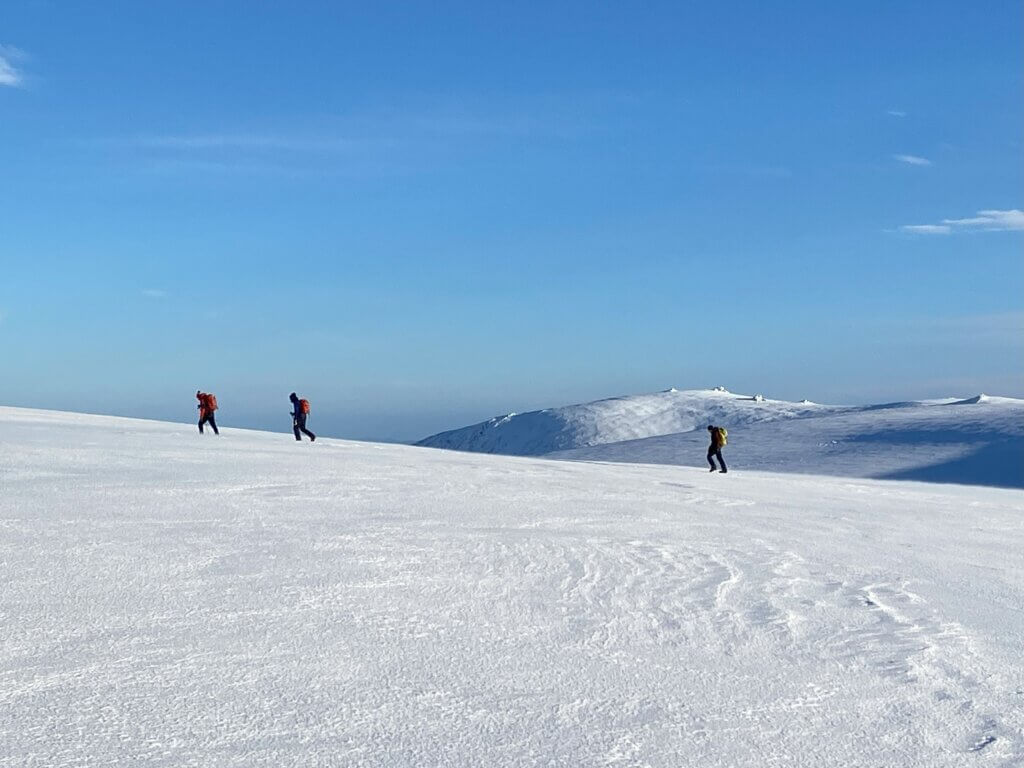
What a view! – New Year Winter Walking 2022 – 2023
The cold temperatures of winter naturally deter many would-be hikers, leaving the trails quieter and more serene. This means fewer crowds and more opportunities to immerse yourself in the solitude of Scotland’s wild spaces. With fewer distractions, you can fully connect with nature, reflect, and appreciate the tranquility of your surroundings. Imagine having iconic trails, like those in the Cairngorms or around Ben Nevis, almost entirely to yourself. It’s an unparalleled chance to experience Scotland’s rugged beauty in its purest form while hiking in winter.
Winter unveils a strikingly different perspective of Scotland’s landscapes. The absence of lush greenery exposes the raw, rugged beauty of the mountains—from dramatic rock formations to stark, snow-covered terrain. If you’re lucky enough to encounter fresh snowfall, the transformation is magical. The pristine white blanket enhances the contours and textures of the land, offering photographers and nature enthusiasts endless inspiration during their winter hikes. Plus, winter often brings incredible sunrises and sunsets that bathe the snow-dusted peaks in hues of gold and pink, perfect for unforgettable photos.
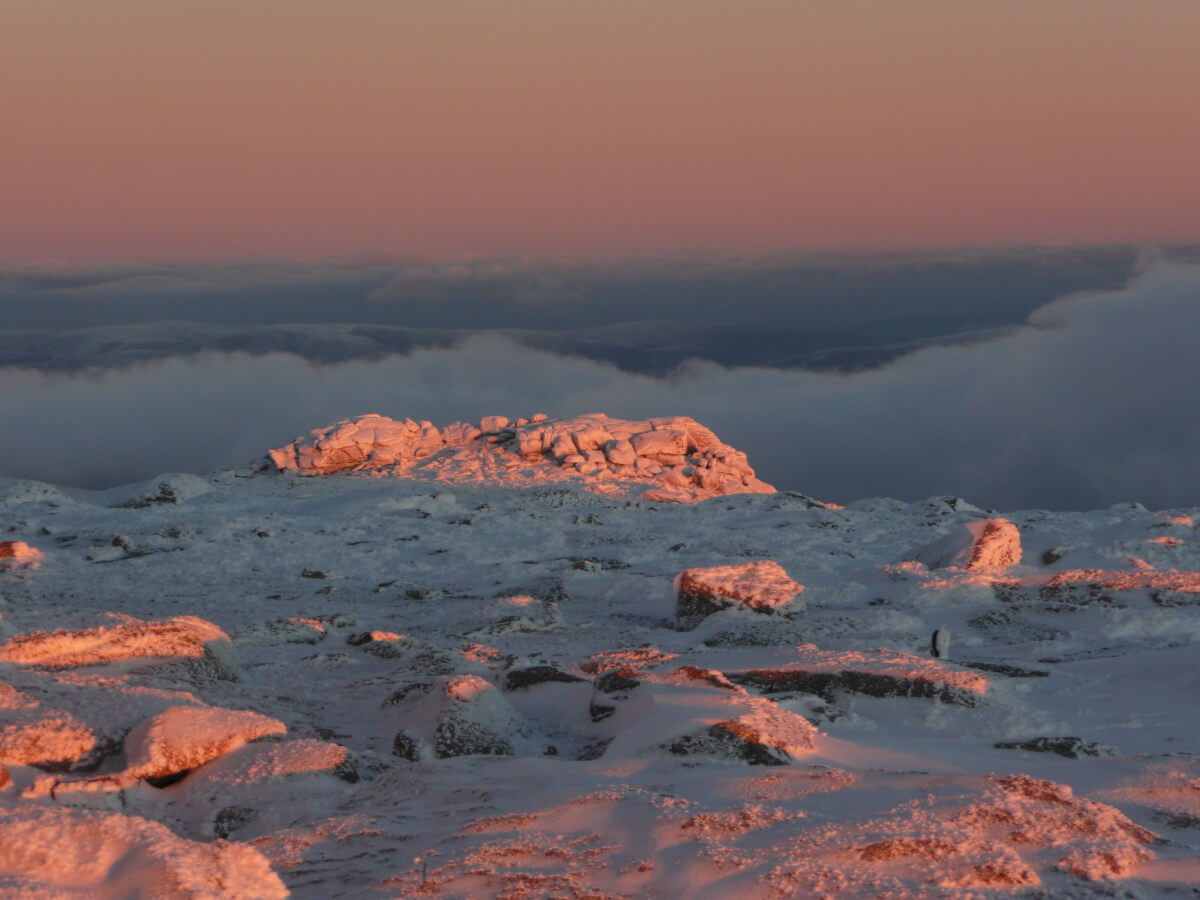
Winter sunset colours glowing on the snow covered Cairngorms
For the fitness-minded adventurer, hiking in winter provides an added bonus: increased calorie burn. The colder temperatures force your body to work harder to stay warm, meaning you’ll burn more calories compared to hiking in warmer weather. Add in the effort of navigating snow-covered paths, and your winter hike becomes an even more rewarding workout. Studies suggest that cold-weather exercise can burn up to 30% more calories, making winter hikes both invigorating and beneficial for your health.
Hiking in winter introduces unique challenges, from navigating icy trails to managing colder temperatures. These added elements demand a different level of preparation and skill, but they also offer an unparalleled sense of achievement. Conquering a winter hike builds confidence and leaves you with stories to share for years to come. Proper preparation—like wearing crampons and layering effectively—can transform these challenges into exciting opportunities to learn new skills. Plus, the sense of adventure and novelty makes every step more exciting.
If you’re ready to challenge yourself, embrace the season, and experience some of the most stunning terrain and views imaginable, hiking in winter in Scotland awaits. With the Cairngorms averaging over 100 days of snow cover per year, it’s one of the best places in the UK to experience a true winter wonderland. Join Scot Mountain Holidays for a guided adventure that will leave you with lasting memories and a newfound appreciation for this extraordinary season.
Setting off on expedition across the snowy Cairngorm plateau
Scotland is an amazing destination renowned for many things: castles, golf, kilts, haggis and it’s amazing scenery. Scotland is also promoted as an adventure destination. However, there are thousands of people who visit Scotland every year but have no idea of the opportunities they can experience. Your experience is greatly enhanced if you invest a wee bit in expert guidance. Many people list our scenery as one of the motivating factors for a visit to Scotland. It also ranks highly as one of the reasons to go hiking.
Choosing a holiday destination is not always easy. There are a lot of considerations which come in to play. How much time do you have available? How much money do you have available? Do you have a short list to choose from? What images are influencing you? And these days, of course, you have your friends images and reviews to peruse via social media. If you’re a keen hiker, you probably already know, that Scotland has amazing scenery. Maybe you’re putting Scotland on your short list. In our experience running accommodation and adventure holidays in Scotland, it’s still got untapped potential and a lot of advantages as an adventure destination which most people don’t know about.
Waiting for the cloud to clear to reveal the spectacular view which can’t be seen from the road.
Photo credit: Scot Mountain Holidays
Photo description: A guided hiking vacation in the Cairngorms, Scotland – off the beaten track thanks to our excellent, world-beating access legislation.
Everyone has a right of responsible access in Scotland due to The Outdoor Access. You are legally allowed to walk/bike/canoe anywhere they wish. You do need to avoid the immediate grounds of a building. So you don’t have the right to walk across someone’s manicured garden. You do have the right to roam the hills at will without sticking to what few paths there are.
Do be careful when out on the high ground though because there is not a system of well-maintained way marked paths across the hills, unlike other European countries. In fact, if you have not been out hiking in Scotland before it would be advisable to book a local guide for the first time you go out. You will have a more in-depth appreciation for the countryside you’re walking through with your guide.
The guide would have extensive knowledge of:
which you as a visitor would never be able to glean during your short visit to the area without his/her presence.
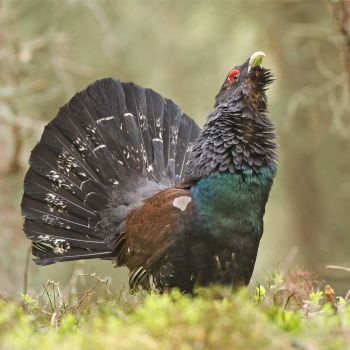
Photo credit: Jamie MacArthur (www.ornithography.com)
Photo description: A Capercaillie in the Cairngorms
Scotland has celebrated the Year of Natural (2013) and the Year of Adventure (2012). The Golden Eagle was voted Scotland’s most iconic species. The attraction of the wildlife is a growing sector of tourism in Scotland, particularly to the Highlands and Islands. You could expect to see red squirrels, red deer, reindeer, roe deer, eagles, otters and a multitude of other animals throughout the Highlands. Most of these iconic animals are frequently found in the Cairngorms. The Cairngorms feature heavily in all the BBC Spring, Autumn and Winter Watch programmes. However, you don’t need to worry about bear or wolf attacks. There are no large animal predators in the wild. Camping is a relatively safe experience; the main concern being a biting fly known as the midge (which will not trouble you on a windy day and is only around in the main summer months).
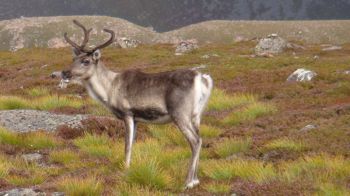
Photo credit: Scot Mountain Holidays
Photo description: Part of the Cairngorm Reindeer Herd which roam free in the hills during the summer months.
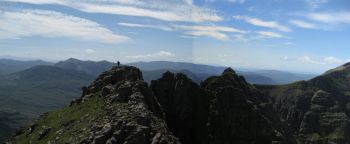
Photo credit: David Webster
Photo description: Ridge walking on Liathach, Torridon, Highlands of Scotland with Scot Mountain Holidays
Scotland has ancient mountain scenery full of mystique and history, which draws thousands of tourists every year. Most visitors only experience the views from the road. There are plenty of views to be seen from the roadside, but the best of the landscape can only be experienced by immersing yourself. Exploring the Highlands without a car has its trials but hiking, canoeing, adventure biking etc here in the Highlands is the way to go.
The beauty of Scotland speaks for itself in many images and has formed inspiration for movies and art worldwide:
There are several long distance paths which are waymarked across Scotland, but the high hills are not waymarked. There are paths which crisscross the high mountains but a knowledge of map reading and compass work are necessary to deal with the changeable weather conditions and wild scenery.
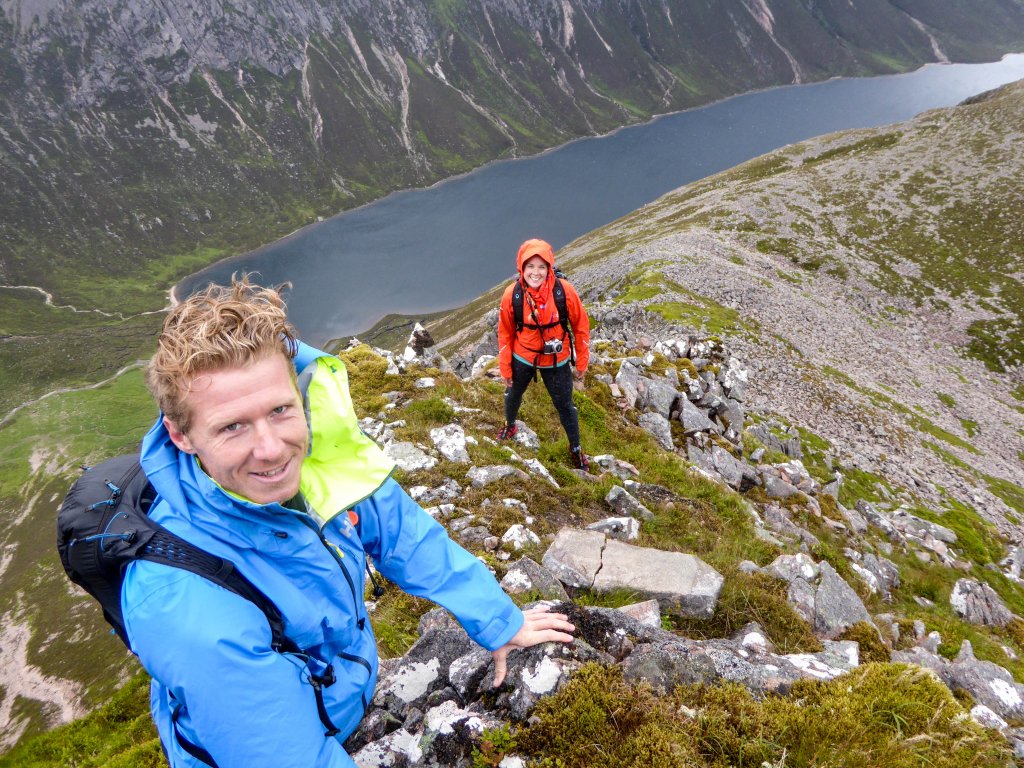
Happy snaps mid climb
Photo description: Viewpoint obove Loch Aan in the Cairngorms showing the cliffs by shelter stone. Some of the stunning features of the Cairngorms which can’t be seen from the road.
Scotland’s highest peak is Ben Nevis at 1,344m. To many Europeans this seems merely a bump, but when you consider that the route up the mountain starts at sea level, it becomes a decent mountain day. Most people take about 8 hours to complete the route up and down Ben Nevis, even by the regular “tourist” route; but for all that it is not an 8000m peak it should still not be under-estimated.
The changeable weather conditions, our maritime climate, in the UK make an ascent of any of the hills challenging, except in the most stable of weather conditions. People do die in our mountains every year. You don’t need to worry about altitude sickness or having to carry oxygen to summit the mountain and most summits can be reached without any need for ropes. All risks in the mountains can be limited by employing a guide with the relevant training and experience.
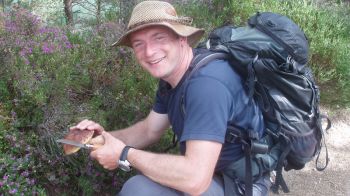
There are international flights to Scotland through Edinburgh and Glasgow with onward flights or good public connections through bus and train onwards to the Highlands. However, to make the most of your time in the Highlands your best transport option is still either to hire a car or to book a suitable tour with a guiding company which will take in the routes at the top of your list or allow them to pick to routes best suited to your ambitions, taking account of the prevailing weather and terrain conditions.
You can reach most of the hills in Scotland on a day walk, within the capabilities of most hikers. There are more extensive routes – which take several days to complete, but you can reach the summit of most individual peaks in a day.
If you do choose to undertake any of the long distance routes you will find that with the exception of the West Highland Way and possibly the Great Glen Way, you are unlikely to see many other people during your walk. So far, Scotland is accessible without being crowded.
The following companies are expert at arranging walking tours and hiking holidays of various kinds:
Hiking is the ideal way to explore the Scottish Highlands
Visit Scotland’s walking information
WalkHighlands: A comprehensive resource for any independent hikers planning to visit Scotland:
Check out the Lairig Ghru mention in the top list of walks in Scotland
Ramblers info about walking in Scotland
12 Trail rules you should know
8 of the best long distance hikes in Scotland
How exciting! The approach of the school Easter holidays is always an exciting time here in the Highlands of Scotland, especially in Boat of Garten, as it signifies the start of so many more opportunities to get out and about. Winter can be a bit of a sleepy time, when if you don’t ski, there are far fewer places to go and things to do than during the summer. Many of the castles and other visitor attractions either close or are on such reduced opening hours, you wonder why they bother at all. But once we’re over half way through March, we can look forward to being spoilt for choice

The ospreys should be returning to Boat of Garten in April. The RSPB are poised to open up the visitor centre over the Easter holidays and are closely monitoring the birds on their migration back to Scotland. Unfortunately sometimes the chicks get lost over in Africa, but hopefully our current pair will make it back safely. It’s been a bit of a soap opera down at Loch Garten in recent seasons so who knows what’s in store this year.
The centre itself has been through quite a revamp though so we now have webcams to see the white tailed (sea) eagle’s nest and a goshawk nest as well as the Ospreys.
Your Natural Adventure in the Cairngorms
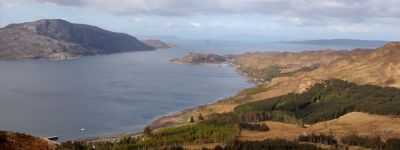
Photo Caption: Wild and remote scenery of Knoydart on a visit in May – Wild Knoydart guided walking holiday
If we think about hiking in Spring, the long daylight hours definitely make it more pleasurable – if challenging to get the kids to sleep when camping. At the beginning of March, we already have 10.5 hours of daylight here in the Cairngorms but by the end of March it’s already increased rapidly and we’re up to 13 hours daylight. For example, March 19th 2015 sunrise is around 6.20am and sunset about 6.25pm. Early starts no longer essential to make the most of the daylight.
Scottish sunrises and sunsets – images from Scot Mountain Holidays
Sunrise and sunset times in the Cairngorms
Don’t kid yourself – it’s hard to keep fit in winter. Even if it’s not snowing, the shorter days and cooler temperatures just bring to mind more images of hibernating than getting outside and hiking or biking.
Of course, there are those (in a large minority) who love winter for the snow, for the skiing etc; but for the rest of us it takes a cattleprod to get out to the gym … but then something magical happens by the middle or February as the days start to lengthen here in the Highlands and all of a sudden it’s not so hard to get up and out. There is certainly a reason why we have the phrase: “The Joys of Spring”. Now we can say goodbye to the inside of a sweaty gym and take the bike out of the shed, dust off the backpack and take the running shoes out in the woods and along the trails.
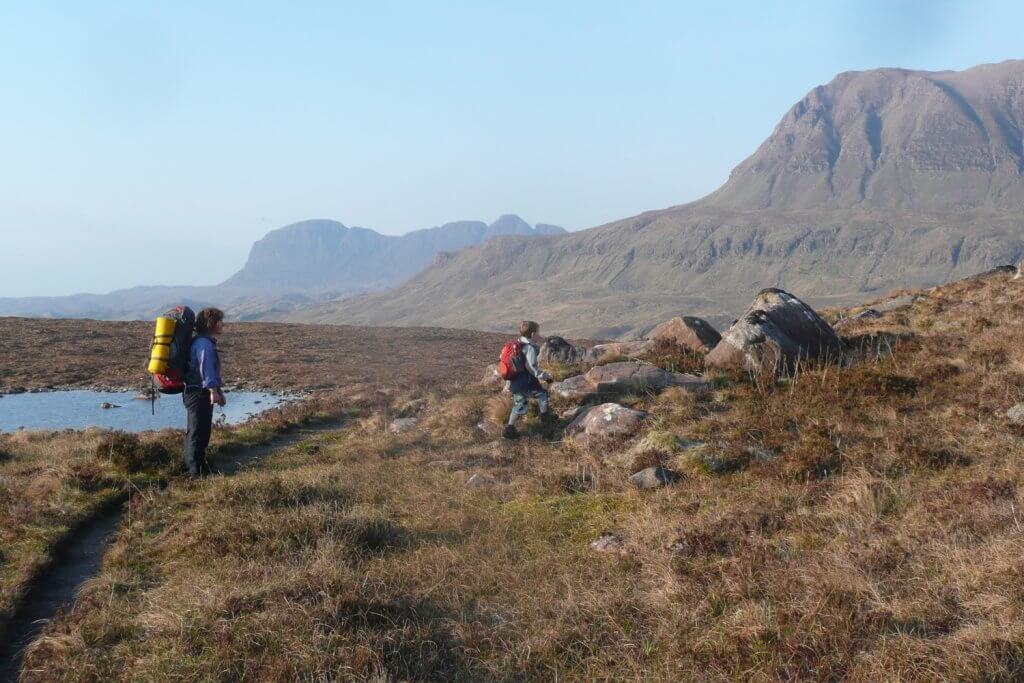
Hiking in to a secret wild camping spot in Assynt
Photo caption: Spring also means that it’s a time the kids can get back outside. You no longer need to wrap them up like Mummies. This photo was taken on a backpack to a wild camp in Assynt in May. If you’d like details of this trip, we can arrange this for small groups and family groups under Andy’s guidance.
In winter, we spend a lot of time instructing about the dangers involved in going out on the snow and ice. Andy runs multiple courses showing clients how to use ice axe and crampons and how to assess the risk of avalanches. All these are things which put the multitude of hikers off. Most people perceive the Highlands as being far too dangerous in winter. You’d almost be taking your life in your own hands to even consider it. Of course, reality is nothing like that and for the number of people who do go out in the hills. The number who have accidents or need to call on mountain rescue is a minute proportion. Accidents are always reported in the media which exaggerates the frequency with which they occur.
Nevertheless, Spring means that these worries can retreat once more and the hiking boots can be dusted off and the maps taken down once more to plan for some high level hikes across the hills. There’s a reason why events such as the TGO Challenge take place in the Spring.
Do bear in mind though – that winter is never far away in Spring here in the mountains and due to our latitude, snow can return with unexpected force in April and May.
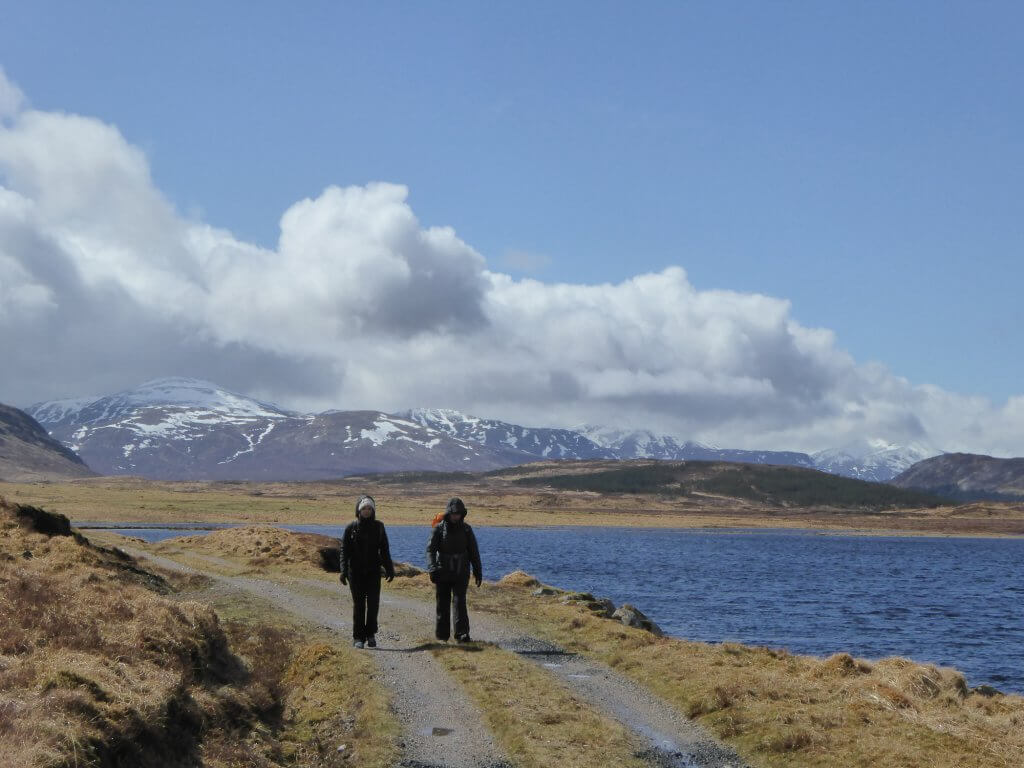
Perfect spring weather for hiking
Hiking in Spring means that you can enjoy long blue sky days, without the ever-present midge. To be honest, in the Cairngorms the midge question is not as great a threat as on the west coast. Despite the relative proximity of the west coast (in Australian or American terms) the weather is very different. In the Cairngorms, the weather is drier and the winters on average colder. Cold winters greatly reduce the presence of midges in the summer.
You can tell our local climatic zone is drier more often than the west coat by the colour of our hills. The hills in the Cairngorms in summer are purple as the bell heather flowers. Bell heather likes dry conditions to flourish. The wetter west coast hills are generally green and grass covered.
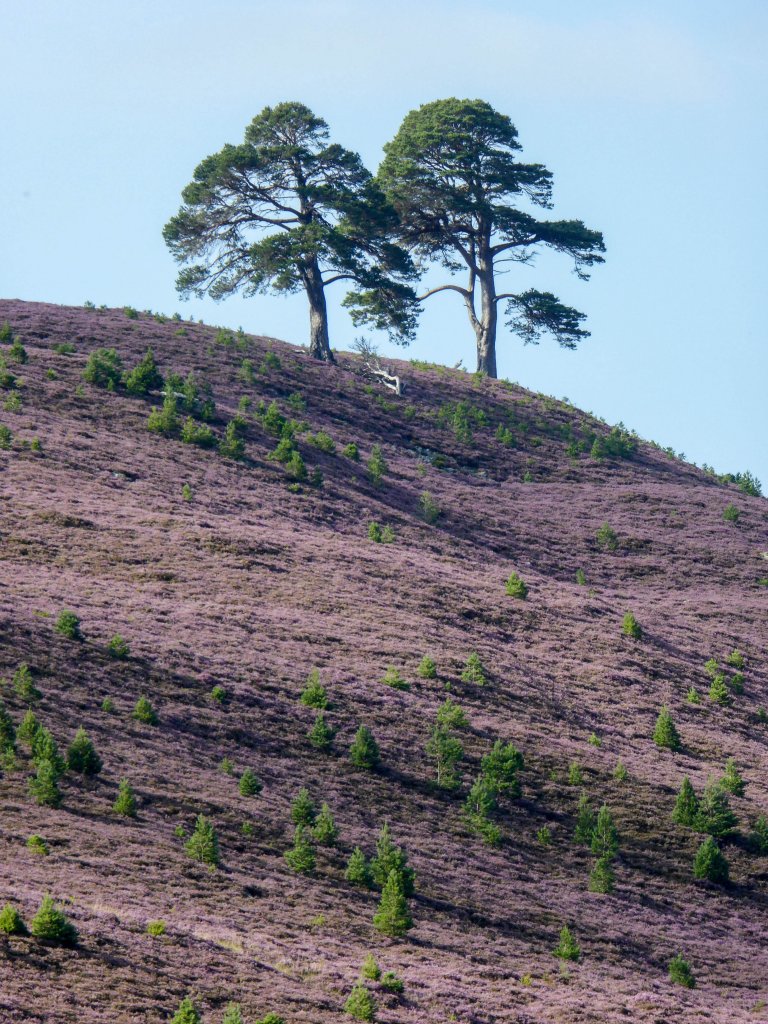
The trouble with planning a hiking vacation in Scotland is that you are almost spoiled for choice. There’s no way you will be able to fit everything in to one vacation.
The scenery on Skye and around the west coast of Scotland is remarkable from the road. It has inspired movies such as “Brave”. The draw is understandable but the disadvantage is that for Scotland it can be “touristy”. It will be unusually busy with other visitors. If you’re looking for a quiet experience of Skye when you have a chance to enjoy the scenery without the crowds, you’ll need to consider taking the time to explore there out of the main tourist season. April, May and September are the best times to head over there. You have a high chance of good weather and a low to non-existent chance of encountering the dreaded midges.
In recent years, particularly since the Land Reform Act (2003), there has been public money available to develop paths across Scotland. This has resulted in a proliferation of way marked long distance routes. The Land Reform Act (2003) formalised the right of access to all land in Scotland, whether privately or publicly owned. Access rights are for outdoor recreation, for crossing land and water, and for some educational and commercial purposes. Exercising access rights, and managing access land, must be done responsibly.
The most well-known of the long distance routes is the the West Highland Way, but there are many others like the Speyside Way (the one to do if you’re in to whisky). Another recently mapped route which is less formally organised is the Cape Wrath Trail. This trail is described by Cameron McNeish as: “It’s the sort of long distance route that most keen walkers dream of. A long tough trek through some of the most majestic, remote and stunningly beautiful landscape you could dare imagine.” You can research more details here: http://www.capewrathtrail.co.uk/foreward.htm There is also a recently published map by Harvey maps covering the area involved.
A full list of long distance paths across Scotland is available here:http://walkhighlands.co.uk/long-distance-routes.shtml They range in length from 338km to 38km. Some can be linked together to make a longer route.
The disadvantage, depending on your point of view, of most long distance paths in Scotland is though they go through mountainous areas most if not all of these routes do not go up the mountains so if you stick to the waymarked route you’ll only be admiring the peaks from afar.
Photo Caption: Long distance path walking in Scotland
There has been quite a lot of investment in path construction and signage in Scotland since the development of the Outdoor Access Code in 2002. There are opportunities virtually everywhere to get out of the car and explore a wee bit to a viewpoint or through spectacular woodlands or around a loch etc. The difficulty is in knowing which option to choose.
WalkHighlands can help with this in that all the walks they list are graded and have an estimated length in distance and time. However, possibly the best way of choosing is to ask your hosts at your accommodation for their recommendation of the best walk to choose and if you have a wee bit more time available take advantage of a guided walk as you will gain so much more insight into the area from the guide’s knowledge. There are ranger guided walks in most areas, particularly in the National Parks like the Cairngorms and the Trossachs which will reduce the cost. Some of these walks are even free. Boat of Garten has it’s own ranger service offering guided walks around the woods behind the village. The RSPB also offer guided walks on the Abernethy reserve.
The advantage of booking a walk with a guide is that you’ll be able to get off the beaten track with confidence. You might even be able to do a longer walk or go higher than you would be confident doing on your own.
A guide will also have extensive knowledge of the local folklore, the environment, the flora and fauna as well as the terrain through which you are hiking. There really is nothing better for bringing the area alive to you. As a student or cash strapped tourist you may consider the cost relatively high. However when you look at the cost of eating in a restaurant or your accommodation for the night, you’ll realise that on an hourly rate your guide is not charging a lot of money. A qualified mountain leader will have invested years of training into his qualification not to mention the cost of the training course itself.
A qualified mountain leader (or accompagnateur) will charge from £150 – £200 for a day out. This fee will be split across the clients in the group. The larger your group of family the less the cost per individual. The rewards of going out with a guide for the day are however beyond price as you will learn so much more about the area which you won’t find in the guidebooks.

Most organised hiking tours will explore only one area in depth. While this approach is not for everyone (many people visit a country with a tick list of sights they want to visit – which are inevitably the same spots 90% of visitors also want to see, resulting in overcrowding), if you go on an organised vacation you are often more likely to have a more genuine and authentic experience of the country you are visiting.
It is worth checking that the company you book with has a philosophy which appeals to you. Also that the structure of the trip suits your priorities. For example, if you are thinking of booking with Scot Mountain Holidays but it is important to you to have 5 star hotel style accommodation, rather than a home away from home, you will probably look elsewhere for your trip. The philosophy behind our vacations is that our guests stay within our home. They immerse themselves in the atmosphere and feel comfortable discussing all aspects of life in Scotland.
Of course, if you have enough time you could consider a shorter, organised trip as part of your vacation and tour the rest of the country by car/bus.
Think about access – a major consideration as part of the planning. Some areas of the Highlands are more difficult to reach than others. For our organised vacations we have tried to make it as easy as possible for our guest to access them. We offer pick ups from Aviemore station and Inverness airport. In the Cairngorms, we are lucky enough to be near the major route north from Edinburgh – the A9, which makes it very efficient to get here.
It may look like it isn’t far to reach some areas of the Highlands but travelling on narrow, sometimes single track roads, will take longer than anticipated.
When planning your trip bear in mind that reaching some areas by public transport can be time-consuming. Many of the routes used have to go around rather than through the mountains.
Fancy a guided walking holiday in November? Not a question you hear every day.
One of the most frequent questions we are asked is: how do you cope with the short days in winter? Scotland is not Finland though. We never get 24 hour darkness. Actually it’s the long days of summer which make more of an impact. The shorter days of winter really don’t last that long.
The disadvantage of hiking in Scotland in November is that the day light hours are short though we still haven’t reached the shortest day of the year, so if you’re wanting to do a Munro hike it might be best to book a guide. At the very least, you’ll need to make sure you have a functioning head torch in your pack.
When you go travelling the memories which stick with you are the unusual situations, or the times when you’ve done something different. These chances almost always happen when you meet new people. They give you new advice, or show you something you wouldn’t otherwise have experienced.
Get off the beaten track with us combines at least one guided day with the opportunity to explore on your own following our personally designed routes. When you take up the guided day as part of the “Get Off the Beaten Track” choice, you’ll be opening up an insider’s knowledge. You still get the opportunity to explore independently, but the trip will be so much more memorable and the day on your own so much more enjoyable. “Get Off the Beaten Track” is a safe way to be adventurous and get away from the crowds.
Ben Nevis sees thousands of people plodding up to the summit every year in everything from flipflops to full on winter hiking boots or skis purely because it is the highest peak in the UK.
Ben Macdui, the second highest peak, is a lot less busy. As with all Scottish peaks, care always needs to be taken as it is the weather conditions and the speed with which they can alter, which makes these summits dangerous, rather than their height. Many Europeans are very scathing about the Scottish”Mountains”looking purely at their height in order to assess them and claiming that they can’t really be mountains when they are less than 2000m in height. Look at the Alps they say. Look at the Pyrenees. Those are real mountains. In Scotland, though the mountains themselves are lower in altitude, the climatic conditions are as violent at they can be at 2000 or 3000m in the Alps. Hence, taking a guide to explore across the Cairngorms is sensible thing to do if you are not familiar with the area.
Bear in mind is that there is little waymarking of routes on the high plateau in Scotland. This is yet another way the Scottish mountains differ from Europe. Historically the land has been owned privately here. Waymarked routes have not been developed across the high mountains.
There is a system of networked paths at lower levels and there has been a lot of work in recent years to improve the paths for hikers; a knowledge of navigation is still required for mountain hiking.
The joy of hike in the Cairngorms is to take it to the “brink” – the edge of the plateau where the views down the steep glacial features of places like the Loch A’an amphitheatre are breathtaking. Andy has hiked in the Cairngorms for close to twenty years. He knows the hidden highlights, the history, the plants, the quiet spots where you’re more likely to see unexpected wildlife, where you might bump into the Cairngorm reindeer herd; but even he is always discovering new plants and seeing unexpected wildlife every time he heads out.
On the second day, we’ve put together a shorter route on Cairngorm – but as you can see from the photos below, despite the fact that it is very accessible, you’ll hardly be in the crowds!
Autumn hiking opportunities for everyone
Soft light of autumn combined with mist to produce excellent photography opportunities
Put together a list of the Munros you want to bag this autumn. We’ll make sure you get to tick them off your list – if humanly possible in your timescale.
We can offer:
This package can also be adapted to take advantage of the sleeper service from London to Aviemore station.
Please contact us for a quote or to discuss options with Andy.
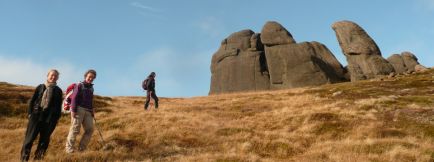
Highlights: Glenlivet whisky, ascent of Ben Rinnes , iconic Scottish wildlife (pine marten and red squirrels).
Hiking, whisky & wildlife – this trip samples the crowning glories of the Cairngorms National Park.
We’re not heading out to bag the highest peaks on this trip; instead we’re bagging some of the top icons of the Scotland’s persona – whisky, wildlife, and the added bonus of some stunning scenery. There’s more to Speyside than whisky, but equally there’s more to whisky than most people are aware. Andy knows all the low-down. (Check out our “how to choose a connoisseur’s whisky” blog).
There was a time that the whisky industry was an illicit trade for smugglers. There was also a time that the wearing of tartan was illegal. All that changed when Queen Victoria made the Cairngorms a venue of first choice for summer vacations.
We won’t quite be hiking in the manner of Queen Victoria, in long skirts, with sedan chairs to take the strain, but we’ll certainly be covering some of the ground the royals enjoy when we’re on the Royal Glenlivet Estate.
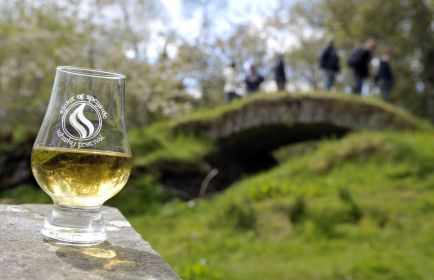
Email us if you think we can help plan your vacation in Scotland – we can hit all the Highland hotspots and include some off the beaten track surprises you might not know about.
For inspiration check out our Pinterest board and our Flickr account.
The challenge of hiking in Scotland can be underestimated. Below we’ve given our top tips for hiking in the Highlands of Scotland. The mountains here are not the giants of Everest or the 4000m peaks of the alps but they are mountains nonetheless. Only the roots remain of what were 7000m peaks in geological history; but they are still a challenge to conquer and offer rewarding vistas to rival those abroad.
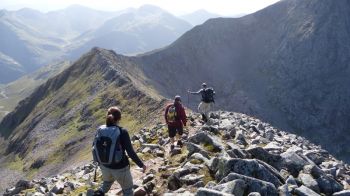
Scotland’s highest peak,Ben Nevis is a mere 1309m above sea level, but the route starts from sea level and ascends all the way to the summit. A climb/hike of 1000m ascent is a good long day out in most people’s estimation and should not be attempted unless you are fully prepared for a mountain day with over the ankle walking boots, extra layers of clothing, waterproofs, food, water, map and compass.
Mountain days in Scotland can involve long routes taking 8 or more hours to accomplish. The Cairngorm 4000ers trip which is run by Scot Mountain Holidays involves one day out whereby the bottom of the mountain is accessed by mountain bike to give at least a small chance of returning to base before dinner. Therefore to make the most of your time during you challenge, you’ll need to prepare beforehand by stepping up your fitness regime to build your stamina. Most challenges will last for more than one day, hence your fitness regime will need to take place more than one day of the week.
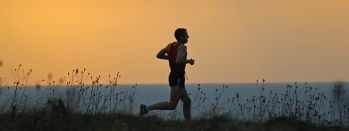
Travelling up to Scotland is not always a cheap option. To get train budget train tickets you either need to know you’re planning to travel 12 weeks in advance; be in the right place at the right time to see a special offer or win a competition; or have a railcard. Booking rail tickets close to your time of travel can add significantly to the cost of your trip.
Flights to Scotland are available from budget airlines like Easyjet and Ryanair, but again the price can vary considerably as there is less choice for flights directly intoInverness- though you could always try linking with flights into Edinburgh.
A guide will know the local terrain like the back of his or her hand. They’ll be able to keep the pace on track, regulate breaks etc so that the day does not extend too late into the evening, it’s their responsibility to manage the group and they’ll have all the necessary emergency equipment and contacts.
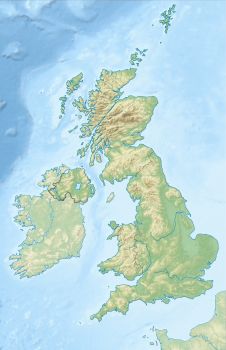
The best sites to monitor are:
The Mountain Weather Information service: the best resource for mountain weather information
The Met Office: go to the specialist forecasts section and check the mountain forecast.
If you also monitor the web cams in the week leading up to your trip it’ll give you an idea of what to expect on the ground.
For the Cairngorms the web cams are:
The weather in the UK, and particularly in the Highlands, is maritime and not continental i.e. it is constantly changing. When people say we can have 4 seasons in one day, they’re not joking – particularly in the spring one minute it can rain, the next snow, the next glorious sunshine … just don’t expect weeks of glorious sunshine; if we did, then Scotland would not be so beautifully green and lush. Always a good idea to have a warm hat and gloves at the bottom of your bag.
You can top up your water bottle from the streams on most of the hills in the Highlands as the water is potable. Dehydration is one of the most insidious hazards dangers in the hills.
In Scotland there are no alpine style mountain huts where you can stop and pick up provisions. There used to be a lot more emergency huts but they have never had wardens or been stocked with provisions. Hiking in the hills here in the UK means that you need to be self-sufficient and be prepared for any emergency. This is a philosophy we Brits take abroad when we hike so you can always spot us in the Alps. We’re the ones with the huge rucksacks with all our emergency supplies as opposed to many of the European hikers with their tiny packs relying on the huts for supplies.
May and September are when we have the longest days and most reliable weather in the Highlands of Scotland. Mid summer has it’s own hazards even if summer thunder storms are less common than in the Alps. We have midges and ticks to contend with in the summer particularly if the weather is still and you are on the west coast (Glen Coe and Skye are hot spots.)
You’ll be able to fit your route on to one side of the map and not have to readjust the map part way in to your route.
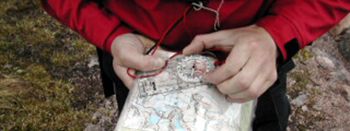
The tried and tested manual navigation aids which will always help you out
Not only do we climb Ben Nevis on this challenge but we do it by the most spectacular and challenging route including the Carn Mor Dearg Arete with stunning views of the cliffs which make up Ben Nevis’ north face. We also ascend Cairngorm via the overlooked north ridge and visit the popular winter climbing venue of Craig Meagaidh also known for it’s long cliff-face. The final route is on Ben a’Ghlo.
All routes are strenuous on their own so fitness is a priority for this trip
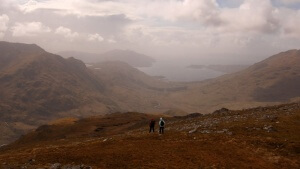 Tramping through the Scottish Highlands is the ultimate way to refresh yourself for the working week ahead.
Tramping through the Scottish Highlands is the ultimate way to refresh yourself for the working week ahead.Climb across Scotland’s rooftop, the highest, most extensive area of mountain plateau with an average annual temperature of zero degrees. This is a challenge you can build into as the longest day is generally the last day of the trip but is bi-modal due to the length of the route. Only the fittest of people attempt this challenge. You must be capable on a mountain bike.
Ascend the classic mountains in the Torridon range. An area of the Highlands which is greatly under-rated, perhaps by it’s proximity to Skye, Torridon has really to be seen to be amazed. Glen Coe, with its dramatic history, and Skye, by reputation and movie fame, receive a far higher number of visitors, but the scenery in Torridon can certainly hold its own in this company
Please enquire for details. Current top destination is Knoydart. Perfect for a sleeper weekend – long weekend would be best to make the most of the opportunity. Hot shower facilities also supplied.
If you’ve already done the West Highland Way, you might be on the lookout for a new challenge.
Scotland is criss-crossed with public rights of way and is blessed with world-beating access legislation. It can make the choice of what to do next more complicated. We’ve picked out some alternatives for you here. Some of the options we’ve listed below may require you to have a wee bit more familiarity with navigational skills, than you might have needed on the West Highland Way.
is a high mountain pass through the center of the Cairngorms National Park. It is a minimum of 19 miles and you can walk it over 1 or 2 days. The main difficulty with the Lairig Ghru is not the length of the walk but the logistics. You can start the walk from either end, close to Braemar or close to Aviemore. However, there are no roads which run through the middle of the Cairngorms National Park. To return to your starting point, you will need to travel for hours by public transport via Aberdeen or Perth.
Alternatively, you could book our Lairig Ghru Logistics package and we will take care of everything except the walking for you. All you need to do is to book your transport to and from Aviemore. We will pick you up from Aviemore (if you’re travelling up by train), transfer you to Fraoch Lodge, feed you, give you a comfy bed and take you round to the start of the walk, then we’ll stay in touch with you so we can be at the end of the walk to meet you. We’ll take you back to Fraoch Lodge, feed you again.
If you would like to take a guide for the Lairig Ghru trip we can also organise this for you.
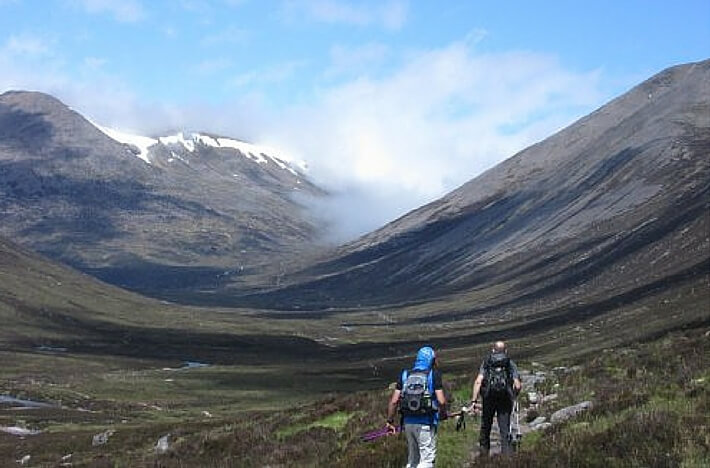
Self-guided Lairig Ghru logistics
The Great Glen Way is almost an extension of the West Highland Way. It runs from Fort William to Inverness. It is 79 miles long and for those of you who don’t know, the Great Glen is home to both the Caledonian Canal and Loch Ness.
There’s a high route alternative which gives a bird’s eye view down on to Loch Ness, but is probably too far away to spot Nessie without very powerful binoculars.
Top Tip: Stop in at the Loch Ness Clayworks tea room. Watch out for midgies if you sit outside on a still day. It’s a lovely peaceful spot above Drumnadochit and if you have a wee space in your pack, the pottery Rebecca produces is lovely. (We have several examples here at Fraoch Lodge.)
It is relatively easy to arrange to walk the Great Glen Way on your own. However, if you prefer the security of knowing that everything is arranged, you can always contact a company like MacsAdventures. MacsAdventures specialise in arranging self-guided long-distance walks for their customers
If you would like to cycle the Great Glen way, we would recommend speaking to “Ticket To Ride” who are based in Inverness. Ticket to Ride can either provide a specialised bike taxi service if you have your own bike, or they can arrange bike hire/a self-guided biking adventure for the whole route.
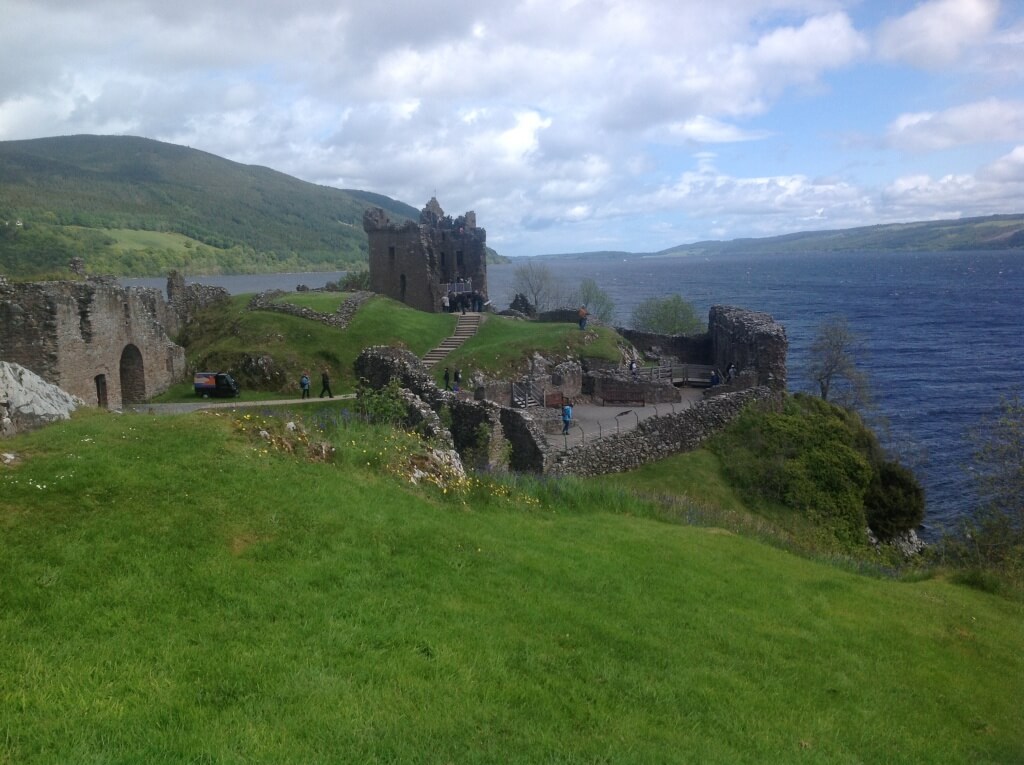
Visit Loch Ness
Moray Coast route.
The Moray coastal route is only about 50 miles long and is equally accessible to cyclists.
This route has marvellous landscapes from rugged cliffs, caves and sheltered coves to fishertown harbours and sweeping stretches of sandy beaches. Moray has a coastline alive with wildlife that would be the envy of many other regions in Britain. Many visitors are drawn by the resident bottlenose dolphin population or by the abundant bird life found along the rugged cliffs.
The Moray Coast has great variety in scenery, and you will always be rewarded with great views out over the Moray Firth. The coastline has great wilderness quality with imposing cliffs and rare plants, but is never far from civilisation. The path links a number of attractive coastal villages and towns, with quaint harbours and extensive services and accommodation.
The route abounds with history. You can see the fishing heritage of the coastal settlements at a number of local museums and the ice houses of Tugnet and Findhorn. Burghead has the remains of a Pictish fort and harbour warehouses designed by Thomas Telford.
TIP: Some of the route is on hard surfaces, particularly in and around the villages, which can be hard on the feet. Personally I would recommend this route as a bike ride. Scot Mountain Holidays can help with the logistics if you have a minimum of 2 people interested in walking or cycling this route.
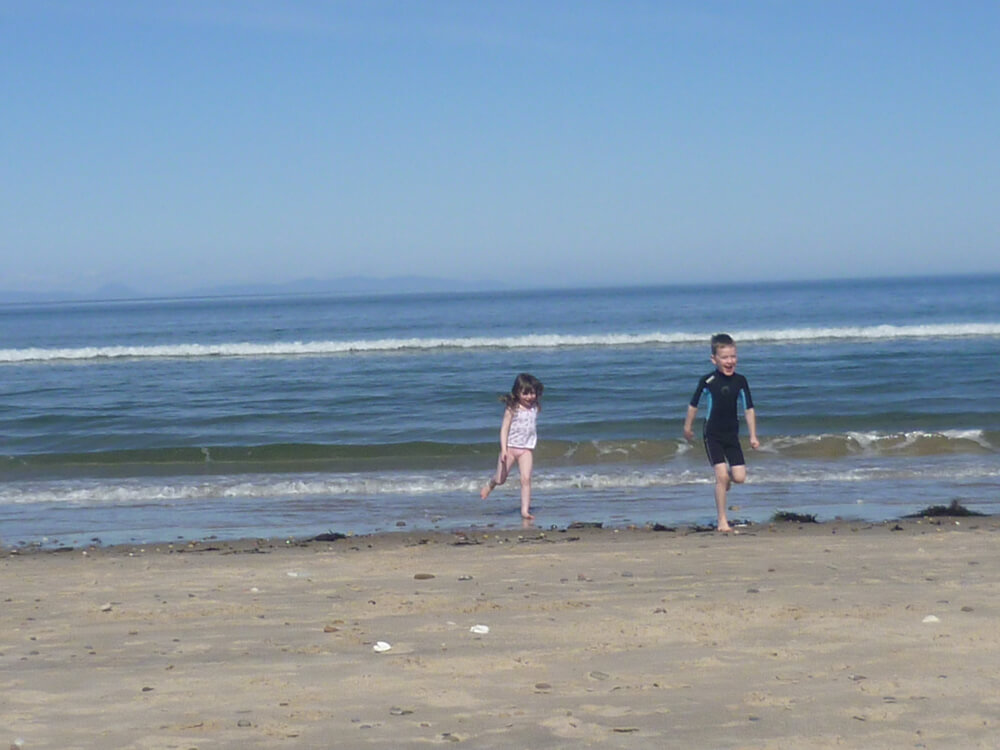
Playing on the beach at Findhorn
This route is on my hit list to do on our mountain bikes. If you choose to do this route, you’ll find it much quieter than the other side of Loch Ness. For this route you’ll need a slightly higher level of fitness as the path is more undulating.
Main advantage: you’ll well away from the main A82 and the crowds who visit Drumnadrochit.
If the weather is in your favour, you’ll have amazing views not only of Loch Ness, but also of the mountains behind. Take a look at the Walkhighlands page for the route. The pictures there are inspiring. Can’t wait to follow this route in the Spring. Only issue – as with all long distance path is co-ordinating the pick up and drop off at the ends of the route, but the public city buses run from Inverness to Dores (one of our favourite spots on the south side of the loch.
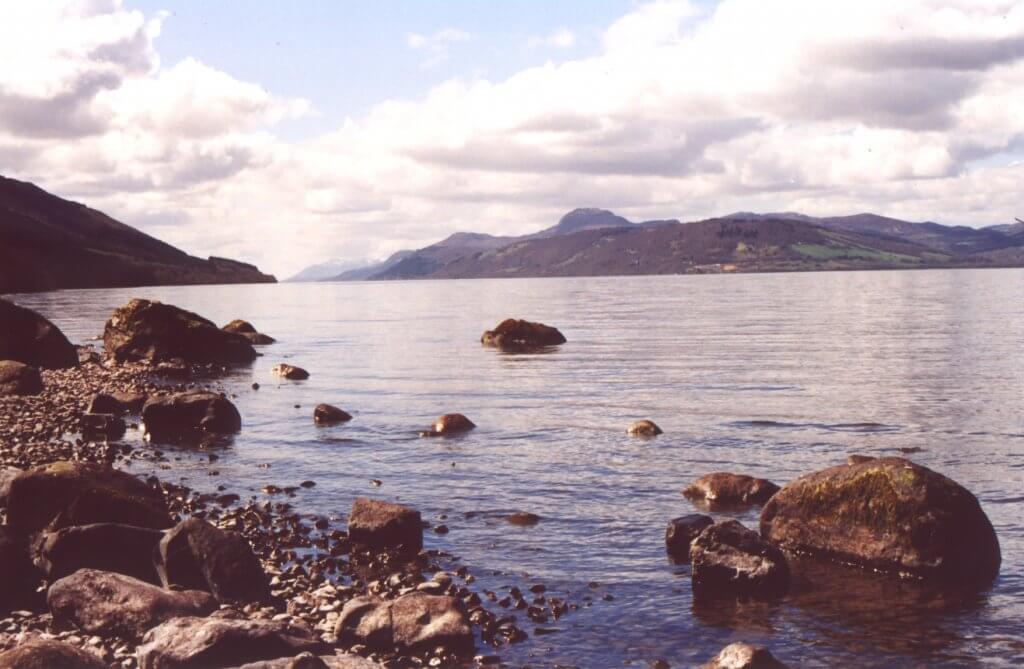
Loch Ness from the shore at Dores
This is the long distance path for whisky lovers. I forget how many distilleries you’ll pass but really you can hardly walk any of the sections without passing a distillery. Unfortunately some of them are not open to visitors, like Knockando, but if you’re prepared to make some small detours you can visit distilleries like Cardhu.
The Way is not exclusively about distilleries though. You’ll also pass through some classic Caledonian Pine Forests on the sections between Aviemore and Grantown on Spey with plenty of opportunities to forage for wild berries (raspberries and bilberries) and mushrooms (particularly chanterelles in the summer).
NB Carrbridge is currently undergoing consultation to install a path which will connect the village to the Speyside Way. Watch this space for more details.
There area already several options to extend the Speyside Way or even to turn it into a loop. You can connect with the Moray Coastal Path, the Dava Way, the Tomintoul Spur, and the Badenoch Way. Quite a diverse option which plenty of opportunities to customise your walk. You can even add in little diversions like a visit to Knockando Wool Mill (a favourite spot of ours) or the Cooperage (where they make the whisky barrels) or Ballindalloch Castle.
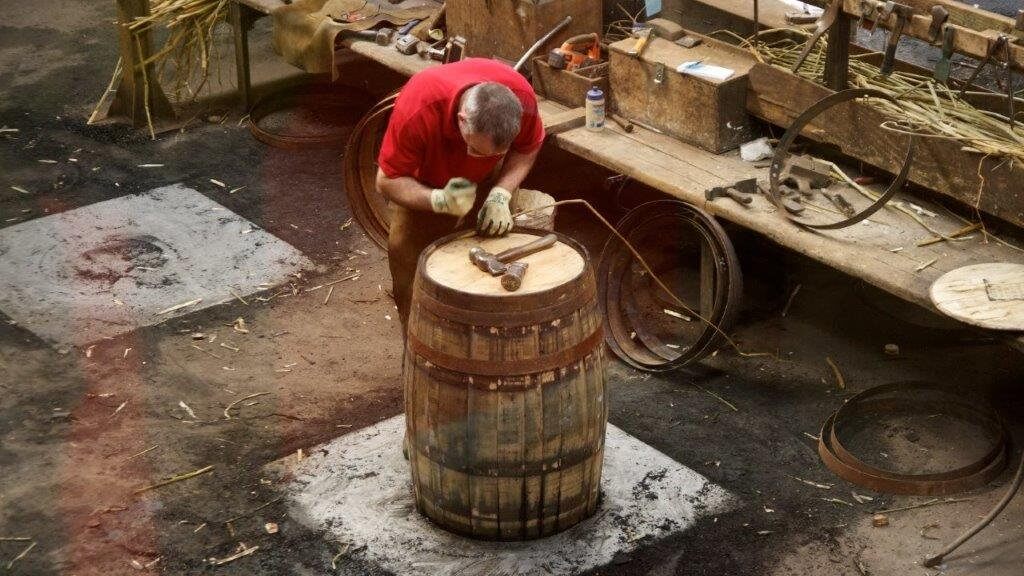
A cooper hard at work repairing casks at the Speyside Cooperage
The Copper Dog (at the Craigellachie Hotel), the Mashed Tun (in Aberlour), Knockando Wool Mill (for a light lunch or cake stop), the High Street Merchant (in Grantown on Spey), Nethy House – cafe with rooms (Nethybridge), the 1896 Gallery in Boat of Garten and the Old Bridge Inn in Aviemore.
A completely customisable, tailor-made adventure which starts with one day of guided exploration or navigation training in the Cairngorms. From here you can take your adventure where you please – more guided days, tours or supported exploring under your own guidance. Call us to discuss or for a quote. Check out some of the other experiences which guests have opted for from their bucket lists.
For guided adventures check out our full programme
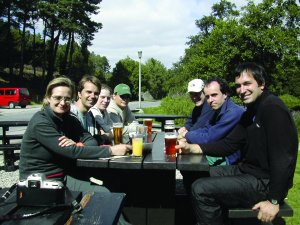 Pub walks in Scotland: the best way of relaxing after a walk, no matter how hard or easy it may have been
Pub walks in Scotland: the best way of relaxing after a walk, no matter how hard or easy it may have beenPub walks in Scotland with good quality craft beers to round off the day would not have been easy in the past. Though Britain is rightly famous for its pub culture, but pub walks in Scotland are not a widely known phenomenon. We can probably attribute this to our Presbyterian heritage. The image of the Presbyterian minister breathing fire and brimstone and going on about the evils of drink and merriment have a lot to answer for.
10 years ago, beer aficionados moaned about the lack of craft beers. Fortunately all this has changed around completely now and we’re spoiled for choice, particularly in the Cairngorms. Those pubs which have maintained their traditional links with brewing and good food are doing very good business. Many of them are in fabulous walking country. We’ve picked out 5 of the best for you to explore on your way round Scotland. You’ll also be pleased to know that we’ve included some of these gems on our hiking tours, like the Highland Extravaganza.
On the banks of the river Spey, looking out over the Cairngorms, the Old Bridge Inn is one of the best pubs. They stock beer from the local brewery (Cairngorm Beers) many of which are on tap. They also have an amazing varied menu and serve both pub meals and restaurant fare. If you have a large group, booking is advised.
Recommended walks:
Check out our self-guided mountain biking holidays which include some of these routes.
Both the Winking Owl and the Cairngorm Hotel are in central Aviemore, on the main street. The Winking Owl is now owned by Cairngorm Brewery and its primary focus is on serving good quality food and beer. The menu is typical pub fare but is nicely presented and offered with a range of Cairngorm beers. The atmosphere is relaxed.
The Cairngorm Hotel is directly across the road from the railway station. It can get extremely busy, particularly when there are sporting events on. Don’t expect a quiet romantic meal.
Recommended walks: Craigellachie Nature Reserve
The Moulin Inn is a hotel but also a pub. It is extremely popular with walkers as it is at the bottom of the popular route suggested below. It is not be be missed if you are in the Pitlochry area as there is not much else in Pitlochry to write home about, apart from the tearoom. There is usually a comfortable, glowing open fire welcoming guests and the menu is quite comprehensive. We recommend the lamb shank and the raspberry crumble!
Recommended walks: Ben Vraikie
For other suggestions in the Pitlochry are try WalkHighlands.
Rightly famous for their seafood, the Applecross Inn is in a beautiful setting, surrounded by the stunning peaks of Wester Ross. The inn also offers great views across to Raasay and Skye, if it is possible to sit outside without being pestered by the midges. The Inn offers an award-winning menu, using high quality local produce like venison, alongside the seafood. It’s also a great destination for sea kayakers. Judith and her staff are also rightly proud of the Gold green tourism award and are open all year round.
Recommended walks:
An easy walk between two beautiful sandy bays with great views of Raasay, Skye and Rona. The walk can be done in either direction or as a return walk – the time and distance given are for one way.
A short hillwalk taking advantage of a start at over 2000 feet. Sgurr a Chaorachain is a Corbett summit, and though easy to reach has very dramatic mountain views.
is deservedly recognised as the home of Scottish mountaineering. The food is top quality and the welcome warm. You will almost always find walkers and climbers relaxing here. The Claichaig prides itself on its friendly atmosphere, its range of real ales and its live music. Check their website for details of whats on during your visit to the area.
Recommended walks:
Further reading:
https://www.ordnancesurvey.co.uk/getoutside/local/loch-achtriochtan-highland
https://www.ordnancesurvey.co.uk/getoutside/guides/top-5-short-hikes-in-scotland/
Another popular walking pub with an associated campsite like the Clachaig. Unfortunately the position of the Sligachan doesn’t really lend itself to gentle half-day circular walks (the Cuillin are in the way), but the situation is so fabulous that really even if you walk out and back along the same path, you’ll still get the most stunning views that Skye has to offer.
 Sunset over Am Basteir from Sligachan on the Isle of Skye during the Skye Munros itinerary
Sunset over Am Basteir from Sligachan on the Isle of Skye during the Skye Munros itineraryRecommended walks:
A gem of a pub with plenty of outdoor seating on the south shore of Loch Ness. You can even dabble a toe in the Loch if you want right from the car park. A traditional pub concentrating on serving food and drink. There is a good selection of beers and food. Sunset dining with a view over Loch Ness is recommended, but it is also a great lunch stop too.
Recommended walks:
Do you know of any great walks which start and finish at pubs in the Highlands? Please get in touch with your recommendations.
If you’d like to go guided on a walking holiday in Scotland please don’t hesitate to contact us for dates, prices and opportunities.
For a full list of all the trips available with Scot Mountain Holidays: cycling/biking, walking/hiking and family adventures – check out the home page
Walking is one of the best forms of exercise being gentle, easy and free. It’s something everyone can do, and extremely beneficial to your wellbeing. So, it’s no wonder masses of people are beginning to introduce walking to their daily lives. But to keep the habit up it’s important to ensure you’re not letting your walking become a chore. So to avoid this, try these easy steps to turn a walk into an adventure.
Walking has been proven to assist you in maintaining a healthy weight, prevent or manage various conditions including heart disease and high blood pressure and additionally, it strengthens your bones and muscles. Not only this, but it’s extremely positive to your mental wellbeing. And, it’s a great excuse to take some time for yourself.
Firstly, it’s time to get off the beaten path. Head away from the pavement and hit the trails. The Cairngorm National Park is full of gorgeous forest, river and mountain walking so you’re rich for choice.
Once you’re away from the roads, and traffic of the world, take some time away from technology. Leave your phone at home, turn the music off and appreciate the beauty of nature. This will not only be a refreshing break and an opportunity for you to restart. But, you will find yourself so much more connected to nature, and you’re much more likely to spot wildlife and fauna. This will add a level of appreciation, and excitement to your walks.
This goes hand in hand with switching off. If you have some sense of direction, try to avoid planning out your route prior to your walk. Follow your instinct, keep things fresh and go somewhere new each day. Making a split second decision at each fork you come to, will add a sense of exhilaration to your walking adventures.
These three easy to do steps will be just the thing to turn your walking into memorable adventures.
The Lairig Ghru is the most prominent pass through the centre of the Cairngorms National Park. A road has never been built through the middle of it. It used to be a drovers’ pass for taking the cattle to market, but is now a route for walkers and cyclists to pass through the centre of the Cairngorms National Park. It runs roughly north-south from Aviemore to Braemar and is a prominent feature on the mountain skyline from Aviemore.
Hiking into the heart of the Cairngorms
Photo credit: David Mansell
The main roads all circumnavigate the Cairngorms National Park which means that to drive from one side near Braemar, to the other, near Aviemore, will take close to 2 hours. To access either end of the route you’ll need to make a massive diversion on public transport via either Perth or Aberdeen, as there is no longer a bus service from Grantown on Spey to Braemar. (The Council sponsored a bus route from Grantown to Braemar – the Heather Hopper, but when funding ran out no one took the route on.)
The route for hikers through the pass is 19 miles from Linn of Dee to Whitewell. However, if you plan to organise your own walk you’ll need to arrange for someone else to make the 2 hour diversion to the other end to meet you and take you back to your start point, or allow for the extra walk from Linn of Dee to Braemar, an additional 18 miles and perhaps the additional mile to Coylumbridge (and possibly from there to Aviemore if you miss the bus.
Traversing the Cairngorms on the classic Lairig Ghru route, which used to be a drovers road
Photo Credit: Scot Mountain Holidays
The hike is 19 miles (minimum) and passes through the main Cairngorm massif under Ben Macdui, Braeriach and Carn Toul. The high point is at approximately 2000ft, so not a mean feat. The high point is within sight of Aviemore and towards the end of the south – north route we advise. You’ll finish the hike within sight of the Lairig Ghru itself.
Scot Mountain Holidays have put together a package for hikers to make the Lairig Ghru accessible to small groups. We can accommodate up to 8 people in our own transport, but have also arranged the trip for larger groups with additional transport. Max: 14
We offer:
The trip is very popular with couples, but priced on our website for 4 or more people. Please enquire directly with us if your group is smaller than 4 people. We’ll quote you directly.
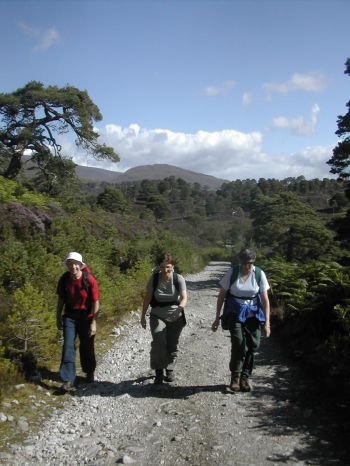
Photo credit: Scot Mountain Holidays
Hiking the Lairig Ghru is a challenge in itself which anyone can complete as a charity challenge. It is a well-known and clearly defined goal familiar to most Scottish hikers, though has less of a reputation south of the border. Some mountain rescue teams already offer the route as an organised challenge event. Please contact us if you are proposing to hike the Lairig Ghru to raise funds for a charity.
We can also offer the Lairig Ghru as a guided option which might be a good option if you are on your own as we are not able to combine self-guided groups for insurance reasons. Please phone: 01479 831 331 for full details or visit our contact us page.
All content © Copyright Scot Mountain Holidays 2025
Responsive web design by Summit Web Solutions